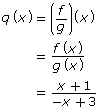Explore
Multiplying and dividing functions is a straightforward process that is similar to adding or subtracting functions. In Try This 1 you found p(x) = (fg)(x) and ![]() Your calculations and domain explanations may have been similar to what is shown.
Your calculations and domain explanations may have been similar to what is shown.
Domain →
Use the x-values where both f(x) and g(x) are defined.
|
where g(x) ≠ 0 and so x ≠ 3
Domain →
g(x) ≠ 0; use the x-values where both f(x) and g(x) are defined, less any value that makes g(x) = 0. |
Determining the range of p(x) = (fg)(x) or ![]() g(x) ≠ 0 can be more difficult. This can often be interpreted from the graph of the function.
g(x) ≠ 0 can be more difficult. This can often be interpreted from the graph of the function.

